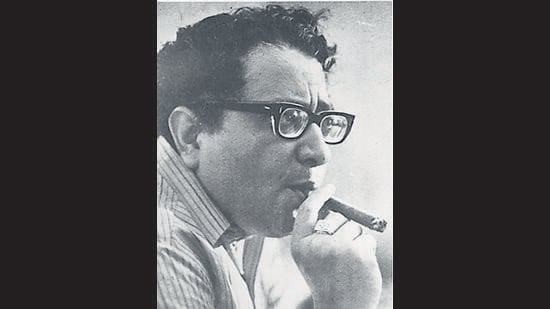Delhi in the 1950s. The novel opens at Connaught Place. The narrator, Madhusudan, has just got off a bus and is on his way to a coffee house. Someone calls out to him. An old friend, Harbans, whom he hasn’t seen in nine years. And that’s how simply one of the most unforgettable modern Hindi novels (one of my all-time favourites) begins.
The book is Andhere Band Kamre (Dark Closed Rooms) by Mohan Rakesh (1925-72). December marks the 50th death anniversary of this formidable Hindi writer, who wrote over 60 short stories, a clutch of memorable plays (including Aadhe Adhure, Ashadh Ka Ek Din, Lehron Ke Rajhans) and three novels.
First published in 1961, Andhere Band Kamre is the story of the middle-class couple Harbans and Neelima’s difficult and painful marriage, as observed by Madhusudan, a journalist whose own story remains in the background, except towards the end of the book. Madhusudan records Neelima’s thwarted ambitions of becoming a Bharatanatyam dancer, and Harbans’s inability to come to terms with his wife’s aspirations and yearnings.
As we follow Madhusudan’s account of the couple’s journey, another character lurks on almost every page: the city of Delhi. These are the first few years after Independence and Delhi is just finding its feet as a free country’s capital. Connaught Place is full of refugee stalls. Residential areas are coming up everywhere to accommodate a huge displaced population.

Madhusudan lives in a grimy, dingy room in Old Delhi. At night, he can hear the infirm, elderly Ibadat Ali playing his battered sitar on the rooftop. Ali had moved to Pakistan during Partition; he came back because he missed Delhi too much. But his house is now occupied by others and he has been pushed to the upper storey.
Delhi took in nearly half a million refugees in those early months. Amid the exodus and influx, the Muslim population of the city fell from 33% to less than 6%. The boundaries of Central, South and West Delhi were extended and new areas such as Khan Market, Lajpat Nagar and Patel Nagar were born.
The older Delhi began fading away. New Delhi had all the glitter now. Connaught Place had glamorous restaurants such as Volga and the dimly lit La Boheme, where Madhusudan takes his journalist friend Sushma for a romantic dinner.
Neelima and Harbans live in a tastefully-done-up house on Hanuman Road, just off from CP; later they shift to Defence Colony in South Delhi. Neelima smokes, calls her husband by his first name and goes with him to the coffee house in the evenings, where she always attracts a great deal of attention from the writers, journalists, poets, critics, artists and theatre people gathered there.
As the city’s famed winter sets in, the pace quickens. Madhusudan’s diary becomes jammed with appointments. Breakfast at Imperial Hotel. Lunch with an MP. A discussion on language politics in the afternoon. An embassy reception or dinner at the Diplomatic Enclave.
Amid it all, he finds time to reflect on the city. When he moves from Old Delhi to a barsati (a tiny single room, on the terrace of a building) in Anand Parbat, he spends his nights gazing at the sprawl of the rapidly expanding capital from the terrace. He can see the new colonies of Tilak Nagar and Rajouri Gardens in the distance, the glow of Palam airport, and the dazzling lights of Chanakyapuri. He can’t see Connaught Place, but can guess its rough location. Anand Parbat is full of tiny barsatis, home to clerks, journalists and teachers who live alone and can’t afford the rent for full-fledged flats.
Real events push their way into the narrative too, such as American President Dwight Eisenhower’s landmark visit in 1959. Journalists go into overdrive covering the event. Madhusudan too is desperate to get some sort of scoop, but fails.
It is a bustling, buzzing, challenging, confusing time. Harbans and Neelima’s marriage flounders on the shores of a new modernity characterised by relentless change. Neelima can keep up. Indeed, she embraces the change. But Harbans fumbles, bitter and unhappy. They can neither live with each other nor without.
As academic Vasudha Dalmia writes in her wonderful chapter on Andhere Band Kamre in the 2017 book Fiction As History: The Novel and the City in Modern North India: “…this is what Rakesh’s novel has caught the spirit of so well: New Delhi in the 1950s… the once proud Mughal city of a once powerful empire, now the capital of the new-born nation, struggling, in a very modernist narrative, to find its way into the modern.”
Enjoy unlimited digital access with HT Premium
Subscribe Now to continue reading

Stay connected with us on social media platform for instant update click here to join our Twitter, & Facebook
We are now on Telegram. Click here to join our channel (@TechiUpdate) and stay updated with the latest Technology headlines.
For all the latest Art-Culture News Click Here

